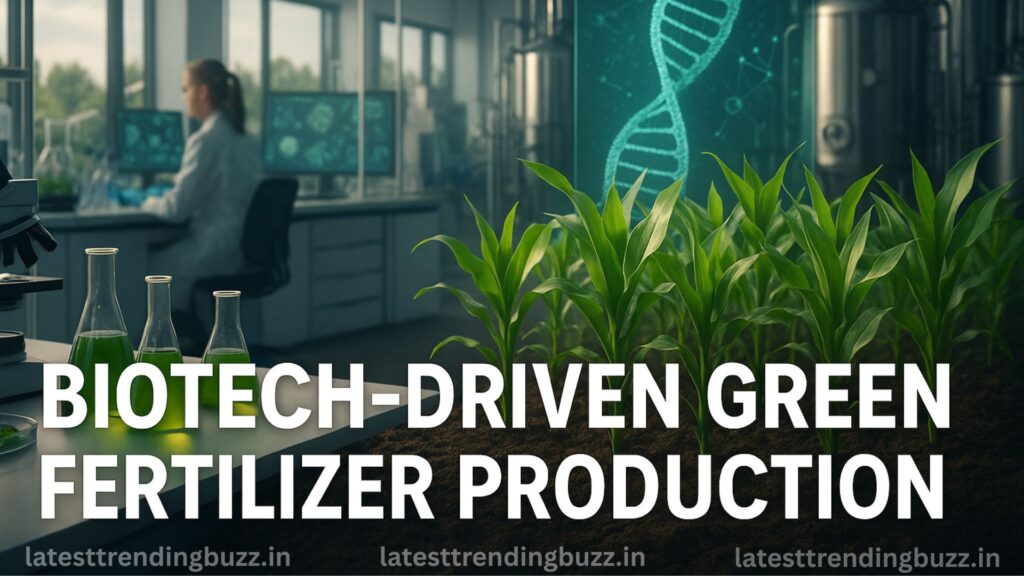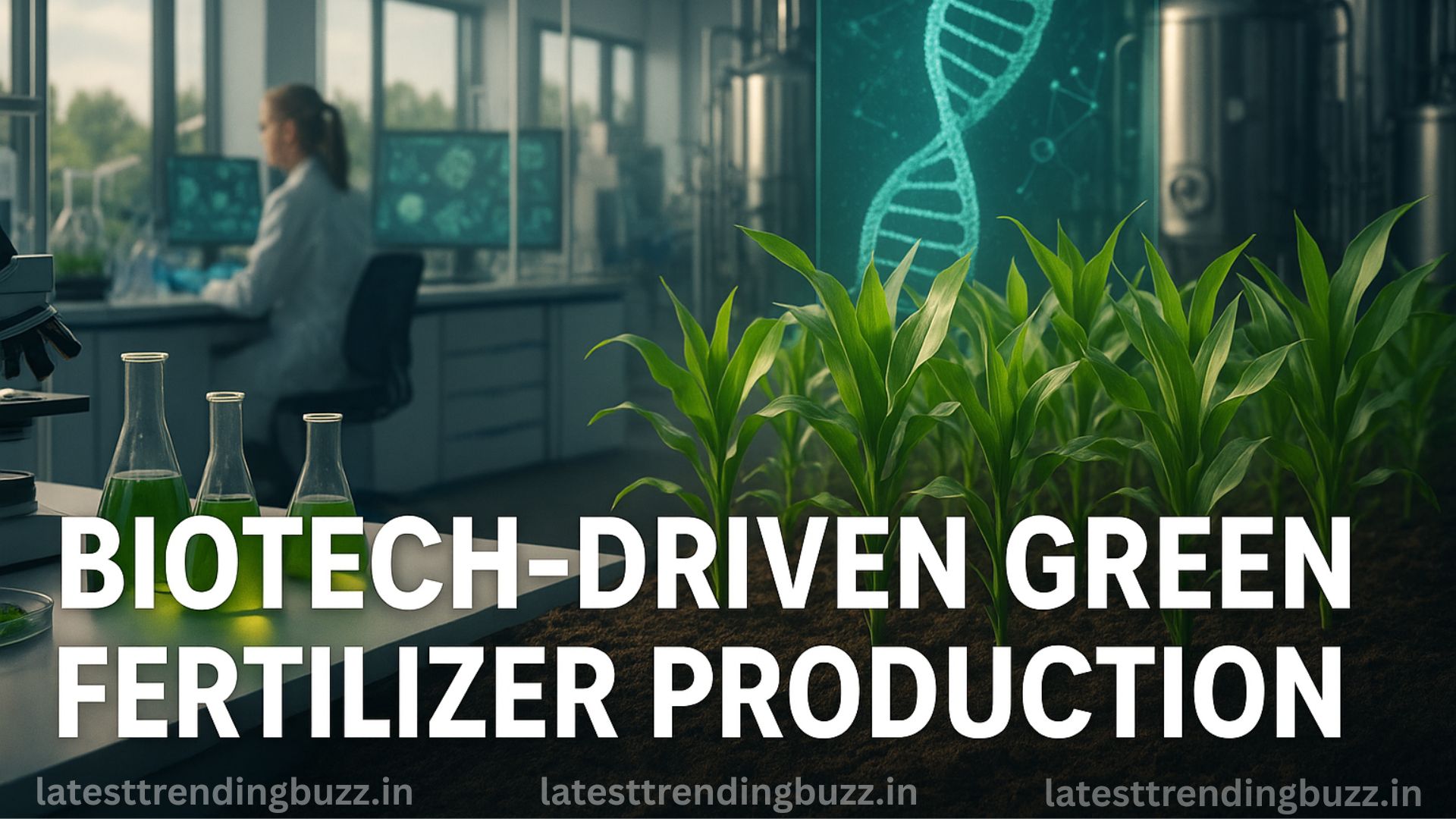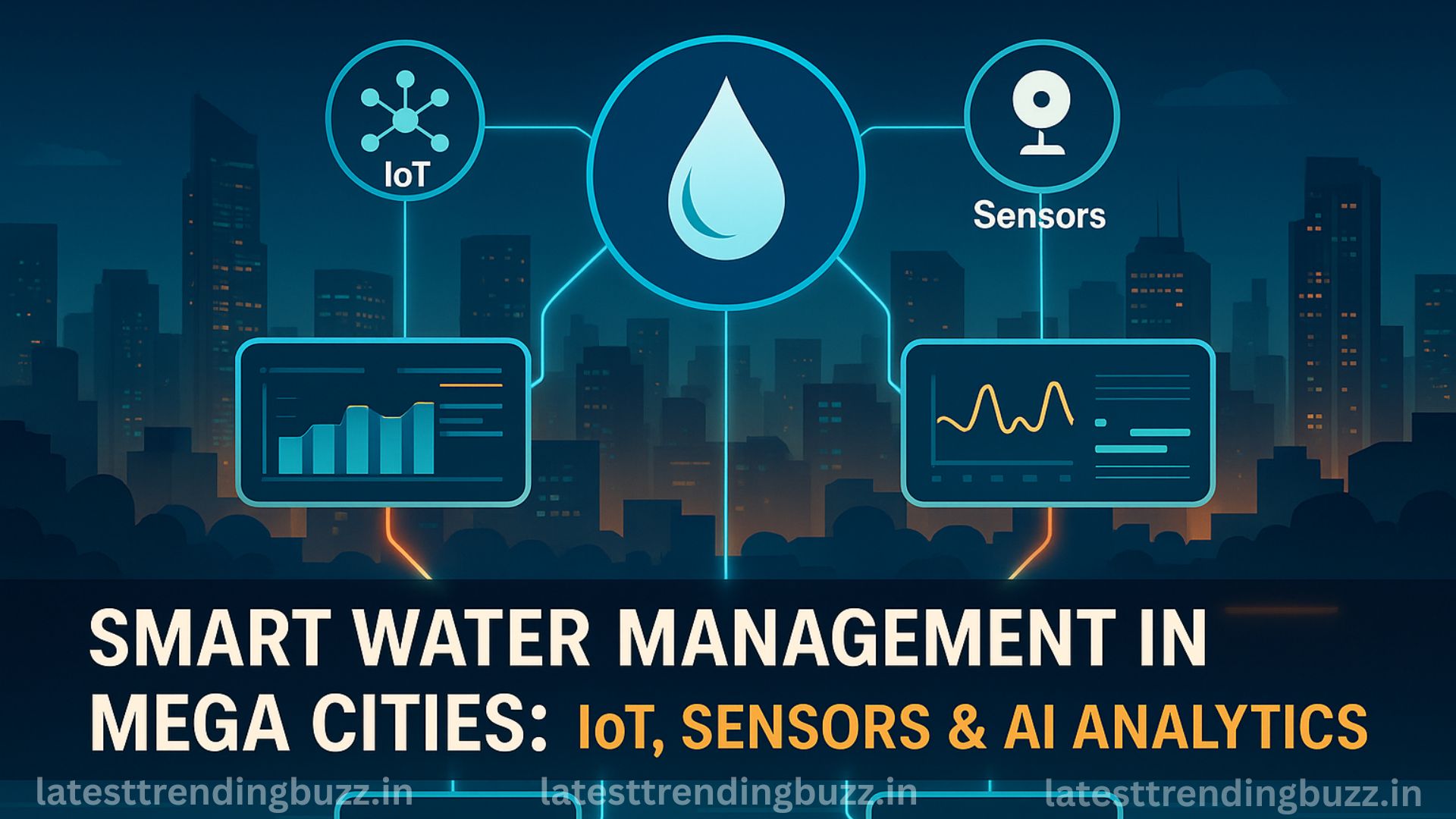The New Green Revolution
In the 1960s, the world witnessed the Green Revolution, which increased crop yields and fed billions. But it came with a heavy environmental cost — soil degradation, water pollution, and carbon emissions from chemical fertilizers.
Now, six decades later, a new revolution is underway: biotech driven green fertilizer production. This innovation harnesses biotechnology to replace or enhance traditional fertilizers with microbial, plant-based, and gene-engineered alternatives that nurture soil health while slashing emissions.
As global agriculture confronts the twin challenges of feeding a growing population and combating climate change, biotech driven green fertilizer production stands as the future’s sustainable answer.
What Exactly Is Biotech-Driven Green Fertilizer?
Unlike conventional nitrogen-based fertilizers made from fossil fuels, biotech driven green fertilizer production uses living organisms and bioengineered enzymes to supply nutrients naturally.
These “green fertilizers” are created using advanced techniques such as:
- Microbial Biofertilizers: Engineered bacteria and fungi that fix nitrogen, solubilize phosphorus, or release potassium directly into the soil.
- Genetically Enhanced Plants: Crops modified to interact with soil microbes for self-sustaining nutrient uptake.
- Enzymatic Fertilizer Catalysts: Biocatalysts that accelerate organic decomposition to release nutrients faster.
- Fermentation-Based Production: Using industrial biotech reactors to produce nutrient compounds without petrochemicals.
In simple terms, biotech driven green fertilizer production replaces factories with living labs — nature’s own biological machinery optimized for sustainability.
Why the World Needs Green Fertilizers Now
1. Rising Environmental Pressure
The fertilizer industry alone contributes nearly 2% of global CO₂ emissions, primarily from ammonia production. Traditional fertilizers also release nitrous oxide — a greenhouse gas 300 times more potent than CO₂.
Biotech driven green fertilizer production eliminates these emissions by using renewable biological processes.
2. Soil Depletion Crisis
Decades of synthetic input have eroded soil biodiversity. Biofertilizers restore microbial ecosystems, improving long-term soil fertility and carbon capture.
3. Global Food Security
With the global population projected to reach 9.7 billion by 2050, sustainable nutrient sources are critical. Biotechnology ensures high yields without environmental trade-offs.
4. Geopolitical Fertilizer Shortages
The Russia–Ukraine conflict disrupted global ammonia and potash supplies. Biotech driven green fertilizer production localizes supply chains by enabling on-site or regional fermentation-based fertilizer units.
Also Read: OpenAI Sora 2 Text to Video Generator: The Rapid Adoption Revolutionizing Creative Industries
How Biotech Turns Science into Sustainability
The secret behind biotech driven green fertilizer production lies in precision biological engineering. Scientists manipulate natural processes — not through synthetic chemicals, but through DNA-level innovation.
Here’s how the system works:
- Microbial Isolation: Identify soil microbes with natural nutrient-fixing ability.
- Genetic Enhancement: Strengthen their efficiency using CRISPR gene editing.
- Bioreactor Cultivation: Grow these microbes in fermentation tanks powered by renewable energy.
- Formulation & Deployment: Package them as bio-capsules or liquid concentrates for farmers.
Once applied, these biofertilizers establish symbiotic relationships with crops — creating a living nutrient loop that can regenerate season after season.
Unlike chemical fertilizers, they don’t “feed” plants temporarily — they transform soil ecosystems permanently.
India Leading the Green Fertilizer Shift
India, being one of the world’s largest fertilizer consumers, is rapidly adopting biotech driven green fertilizer production.
- IFFCO has introduced “Nano Urea,” a biotechnology-based solution that replaces bulky urea bags with a 500ml bottle.
- CSIR and DBT have partnered on microbial nitrogen fixers for smallholder farmers.
- Indian startups are using fermentation technology to produce bio-based ammonia from crop residues.
The government’s “Mission BioAgri 2030” is investing in scaling green fertilizer manufacturing through biotech clusters — positioning India as a global hub for sustainable agriculture innovation.

Benefits of Biotech-Driven Green Fertilizer Production
| Benefit | Impact on Farming & Environment |
|---|---|
| Reduced Emissions | 90% lower CO₂ footprint compared to synthetic fertilizers. |
| Improved Soil Health | Rebuilds organic matter and microbial life. |
| Cost Efficiency | Reduces input costs for farmers over multiple seasons. |
| Localized Production | Enables regional bio-manufacturing reducing import dependency. |
| Higher Crop Quality | Enhances nutrient uptake, resulting in better yields and produce quality. |
The holistic benefit? Eco-friendly farming with long-term economic resilience.
Industrial Scale Innovation
Global biotech firms are rapidly scaling biotech driven green fertilizer production through industrial innovation:
- Pivot Bio (USA): Uses microbes to fix atmospheric nitrogen directly onto roots, replacing chemical urea.
- Novozymes (Denmark): Develops bio-catalysts that convert organic waste into plant nutrients.
- Nouryon (Netherlands): Produces enzyme-based fertilizers that self-regulate release rates.
- Indian BioAgri Startups: Using sugarcane and rice husk waste to produce renewable fertilizer precursors.
These firms use bioreactors, AI-optimized fermentation, and synthetic biology to scale production — bringing biofertilizers to the same cost level as conventional products.
Water and Climate Connection
Traditional fertilizers often cause runoff pollution, contaminating rivers and groundwater.
The biotech driven green fertilizer production approach integrates slow-release nutrient systems that:
- Minimize nutrient leaching.
- Reduce eutrophication in water bodies.
- Improve water retention in soil.
Moreover, biofertilizers enhance carbon sequestration by restoring root-microbe networks, turning farmland into natural carbon sinks.
Inside the Labs: The Future of Biofertilizer Design
The next phase of biotech driven green fertilizer production involves AI-designed microbes and nanobiotechnology.
Scientists are creating synthetic microbial consortia that coordinate like ecosystems, sharing nutrients, and signaling each other to optimize plant growth.
Future fertilizers may even use smart nano-coatings that respond to soil temperature, pH, and moisture — releasing nutrients only when crops need them.
These innovations promise a future where agriculture and ecology work in perfect biological harmony.
Also Read: Gen-Z Financial Wellness Apps: Financial Habits Changing with a Generation
Global Policy and Industry Response
Governments and international organizations are supporting this transition:
- The UN FAO has listed biotech biofertilizers as “critical climate technologies.”
- The EU Green Deal mandates a 30% reduction in chemical fertilizer use by 2030.
- India’s Ministry of Agriculture has rolled out subsidies for verified biofertilizer products.
Private investors, too, are pouring billions into agritech startups focusing on biotech driven green fertilizer production, recognizing it as the next trillion-dollar sustainability frontier.
Market Forecast: The Biofertilizer Boom
- Global Market Value (2025): $13.5 billion
- Projected by 2030: $34 billion
- Annual Growth Rate: 19%
- Asia-Pacific Share: 40% (led by India and China)
Experts predict that biotech driven green fertilizer production will become mainstream by 2035, potentially replacing 50% of synthetic fertilizers globally.
Challenges to Overcome
Even with its promise, biotech green fertilizer faces hurdles:
- Regulatory Delays: Bio-based approvals vary across nations.
- Storage Sensitivity: Living microbes need controlled conditions.
- Farmer Awareness: Training rural communities to adopt new products.
Yet, continuous innovation and policy support are closing these gaps fast.
A Step Toward Climate-Positive Agriculture
At its heart, biotech driven green fertilizer production isn’t just about replacing chemicals — it’s about re-engineering agriculture for a climate-positive future.
By turning fields into biological ecosystems that sustain themselves, biotech is giving humanity a chance to produce food without harming the planet.
The next Green Revolution will be blue and green — driven by biotechnology and powered by life itself.
FAQs
1. What is biotech driven green fertilizer production?
It’s the use of biotechnology to produce eco-friendly, microbe-based fertilizers that enhance soil fertility without pollution.
2. How does it differ from chemical fertilizers?
Instead of relying on fossil fuels, biotech fertilizers use living microbes and enzymes to deliver nutrients naturally.
3. Are these fertilizers safe for crops and humans?
Yes. They are environmentally safe, non-toxic, and improve food quality without harmful residues.
4. What countries are leading in biotech fertilizer innovation?
India, the U.S., Denmark, and China are at the forefront of research and deployment.
5. Will biofertilizers replace chemical ones completely?
Gradually. Experts expect a 50–70% replacement by 2040 as scalability and cost efficiency improve.
Disclaimer
This article on biotech driven green fertilizer production is based on verified scientific research, governmental reports, and industry insights as of 2025. It is written for informational and educational purposes for LatestTrendingBuzz.in readers.














